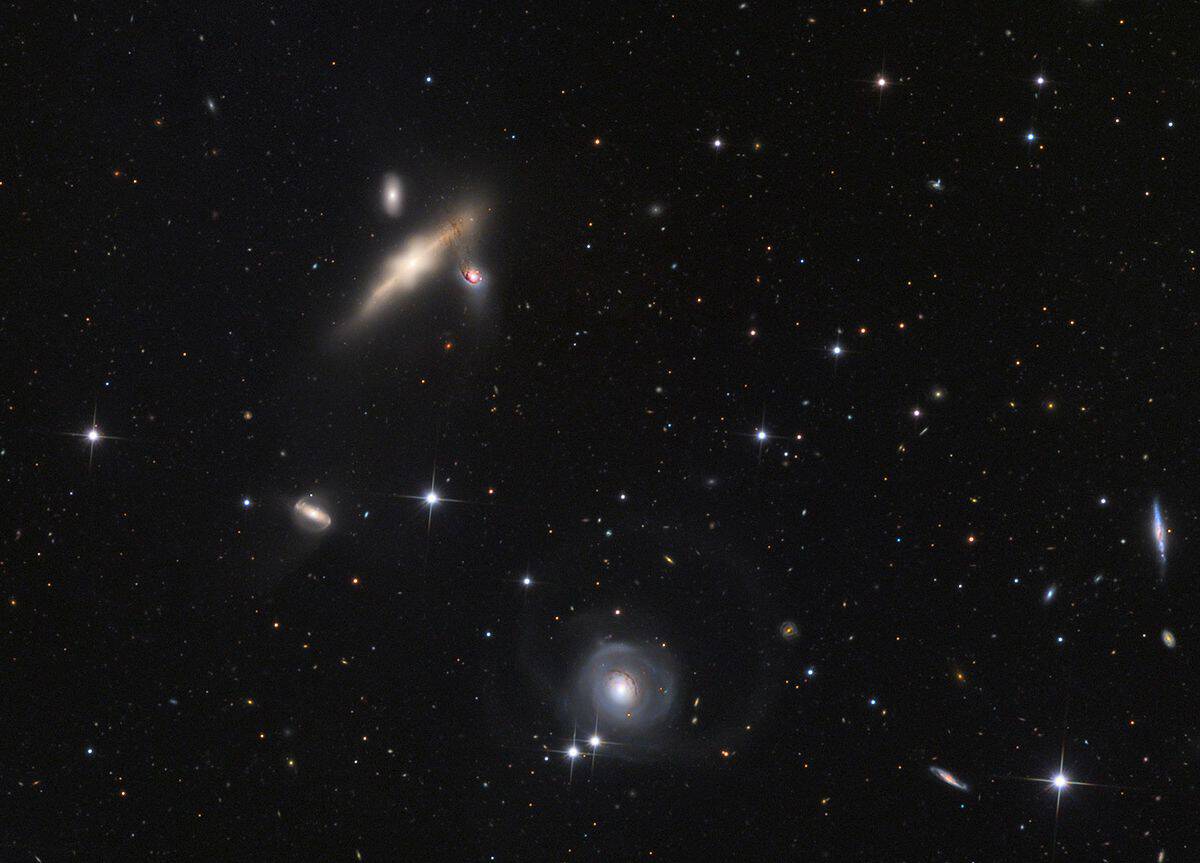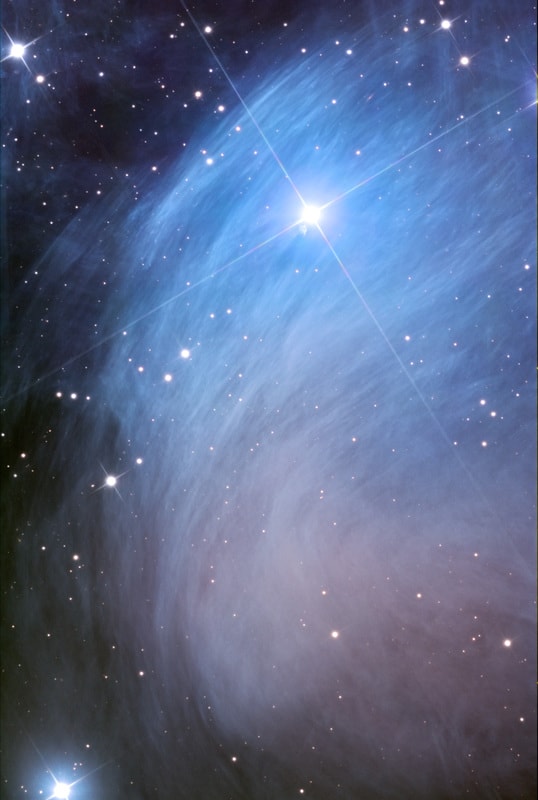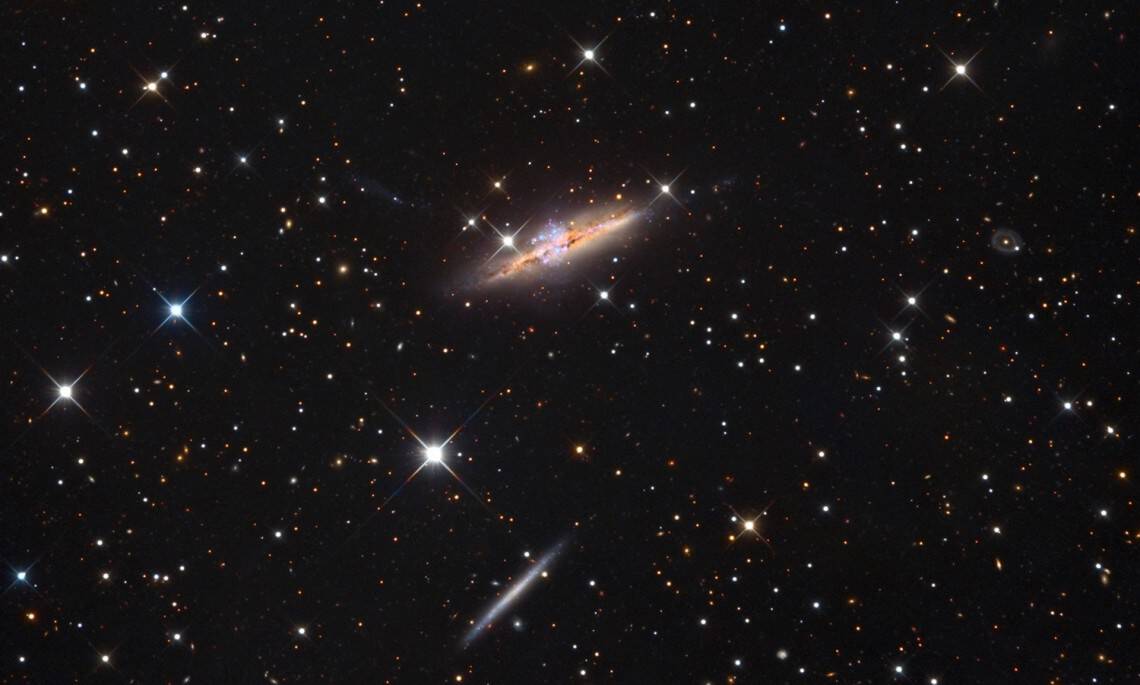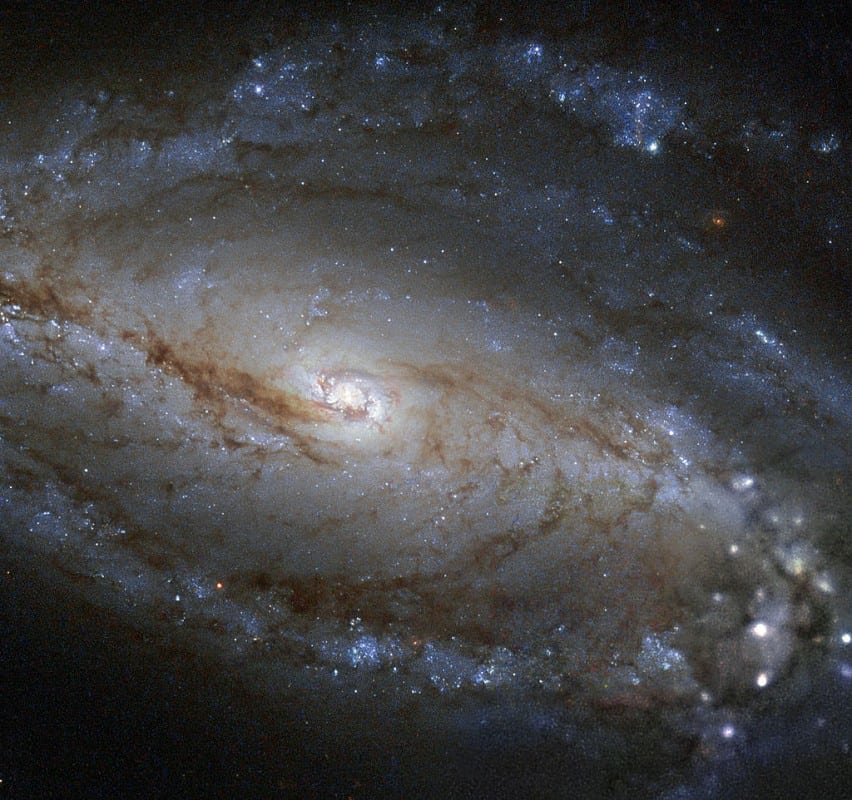Blog
NGC 125 (also known as PGC 1772) is a lenticular galaxy located in the constellation Pisces. It is designated as subclass Sa Ring in the galaxy morphological classification scheme. It lies approximately 235 million light-years away.
NGC 125 was discovered by astronomer William Herschel on 25 December 1790 and viewed with a reflecting telescope with an aperture of 18.7 inches. At the time of discovery, its coordinates were recorded as 00h 21m 41s, +87° 56.1′ -20.0″. It was also observed 12 October 1827 by John Herschel.
Dreyer described NGC 125 as “very faint” and “small,” with a “brighter middle.” It is about 115 thousand light-years across, making it slightly larger than the Milky Way galaxy.
NGC 125 is part of the NGC 128 group, which includes NGC 125, NGC 126, NGC 127, NGC 128, and NGC 130. Though they are in the same galaxy group, the >1000 km/h difference in recessional velocities between NGC 125 and NGC 128 make it unlikely that they are near in space to each other; however, because of their similar redshifts, NGC 125 and NGC 126 are most likely close
more...James Emory Garrison (March 3, 1934 – April 7, 1976) was an American jazz double bassist born in Americus, Georgia. He is best remembered for his association with John Coltrane from 1961 to 1967.
Garrison was raised in both Miami, Florida and Philadelphia where he learned to play bass. Garrison came of age in the midst of a thriving Philadelphia jazz scene that included fellow bassists Reggie Workman and Henry Grimes, pianist McCoy Tyner and trumpeter Lee Morgan. Between 1957 and 1962, Garrison played and recorded with trumpeter Kenny Dorham; clarinetist Tony Scott; drummer Philly Joe Jones; and saxophonists Bill Barron, Lee Konitz, and Jackie McLean, as well as Curtis Fuller, Benny Golson, Lennie Tristano, and Pharoah Sanders, among others. In 1959 he first appeared on record with Ornette Coleman on “Art of the Improvisers” (Atlantic, 1959). He continued to work with many leaders, including Walter Bishop, Jr., Coleman, Dorham, and Cal Massey for the next two years.
more...Dupree Bolton (3 March 1929 – 5 June 1993) was a jazz trumpeter from Oklahoma City, Oklahoma, known for his recordings with Harold Land and Curtis Amy.
more...World Music with Mabiisi from Frafra of northern Ghana
more...Merope, designated 23 Tauri (abbreviated 23 Tau), is a star in the constellation of Taurus and a member of the Pleiades star cluster. It is approximately 380 light years away.
Merope is a blue-white B-type subgiant with a mean apparent magnitude of +4.14. Richard Hinckley Allen described the star as lucid white and violet. It has a luminosity of 630 times that of the Sun and a surface temperature of 14,000 kelvins. Merope’s mass is roughly 4.5 solar massesand has a radius more than 4 times as great as the Sun’s. It is classified as a Beta Cephei type variable star and its brightness varies by 0.01 magnitudes.
Surrounding Merope is the Merope Nebula (NGC 1435). It appears brightest around Merope and is listed in the Index Catalogue as number IC 349.
more...Larry Eugene Carlton (born March 2, 1948) is an American guitarist who built his career as a studio musician in the 1970s and ’80s for acts such as Steely Dan and Joni Mitchell. He has participated in thousands of recording sessions, recorded on hundreds of albums in many genres, for television and movies, and on more than 100 gold records. He has been a member of the jazz fusion groups The Crusaders and Fourplay and has maintained a long solo career.
Carlton was born in Torrance, California in 1948 and at the age of six began guitar lessons. His interest in jazz came from hearing guitarist Joe Pass on the radio. From Pass he moved on to jazz guitarists Barney Kessel and Wes Montgomery and blues guitarist B.B. King. He went to junior college and Long Beach State College while playing professionally at clubs in Los Angeles.[1]
During the 1970s, he found steady work as a studio musician on electric and acoustic guitar in a variety of genres: pop, jazz pop, rock, rhythm and blues, soul and country. Carlton appeared on hundreds of recording sessions with Steely Dan, Joni Mitchell, Linda Ronstadt, Michael Jackson, Quincy Jones, Bobby Bland, Sammy Davis, Jr., Paulinho Da Costa, the Fifth Dimension, Herb Alpert, Christopher Cross, Dolly Parton, Andy Williams, and the Partridge Family. In 1982 he appeared on The Nightfly by Donald Fagen, lead singer for Steely Dan.
https://www.youtube.com/watch?v=VwGHaKbnoL8&index=2&list=RDEMrQ3ZxSE9YXXeOD0FbJkBEw
more...Lewis Allan Reed (March 2, 1942 – October 27, 2013) was an American musician, singer, and songwriter. He was the lead guitarist, singer and principal songwriter for the rock band the Velvet Underground, with a solo career that spanned five decades. The Velvet Underground achieved little commercial success during their existence, but are now regarded as one of the most influential bands in rock, underground, and alternative music.
After leaving the band in 1970, he released 20 solo studio albums. Reed’s second solo album, Transformer (1972), produced by David Bowie and arranged by Mick Ronson, brought Reed mainstream recognition. After Transformer, the concept album Berlin reached No. 7 on the UK Albums Chart. Rock n Roll Animal (a live album released in 1974) sold strongly and Sally Can’t Dance (1974) peaked at number 10 on the Billboard 200, but for a period Reed’s work did not translate into sales, leading him into drug addiction and alcoholism. Reed made a gradual return to prominence with New Sensations (1984), and his album New York (1989) is recognized as the height of his mid period.
In the 1990s Reed participated in a revival of the Velvet Underground, and made several more albums, including a tribute to his mentor Andy Warhol. He contributed music to two theatrical interpretations of 19th-century writers, one of which he developed into an album. He married his third wife Laurie Anderson in 2008, made an album with Metallica, and died in 2013 of liver disease after a transplant.
https://www.youtube.com/watch?v=SKnbFpdGKog
more...Douglas Watkins (March 2, 1934 – February 5, 1962) was an American jazz double bassist from Detroit.
An original member of the Jazz Messengers, he later played in Horace Silver‘s quintet and freelanced with Gene Ammons, Kenny Burrell, Donald Byrd, Art Farmer, Jackie McLean, Hank Mobley,[1] Lee Morgan, Sonny Rollins, and Phil Woods among others.
Some of Watkins’ best-known work can be heard when as a 22-year-old he appeared on the 1956 album, Saxophone Colossus by tenor saxophonist Sonny Rollins, with Max Roach and Tommy Flanagan. From that session, the tunes “Blue Seven” and “St. Thomas,” especially, have become revered not only as evidence of Rollins’ original genius but as fine examples of Watkins’ work.
According to Horace Silver‘s autobiography, Let’s Get to the Nitty Gritty, Watkins, along with Silver, later left Art Blakey’s Jazz Messengers because the other members of the band at the time (Kenny Dorham, Hank Mobley and Blakey) had serious drug problems, whereas Watkins and Silver were tired of being harassed and searched by the police every time they went to a gig in a new city and club.
https://www.youtube.com/watch?v=3hU93L-Ed44
more...NGC 7241 (other designations – PGC 68442 , UGC 11968 , MCG 3-56-20 , ZWG 451.24 , 2ZW 174 ) is a galaxy in the constellation Pegasus .
This object is among the listed in the original edition of the ” New Common Catalog “.
more...Ralph Towner (born March 1, 1940, Chehalis, Washington) is an American multi-instrumentalist, composer, arranger and bandleader. He plays the twelve-string guitar, classical guitar, piano, synthesizer, percussion and trumpet.
Born in 1940 in Chehalis, Washington, Towner has made notable recordings of jazz, third stream under strong influence of folk and world music. He began his career as a conservatory-trained classical pianist, who picked up guitar in his senior year in college, then joined world music pioneer Paul Winter‘s “Consort” ensemble in the late 1960s. Along with bandmates Paul McCandless, Glen Moore, and Collin Walcott, Towner left the Winter Consort in 1970 to form the group Oregon, which over the course of the 1970s issued a number of highly influential records mixing folk music, Indianclassical forms, and avant-garde jazz-influenced free improvisation. At the same time, Towner began a longstanding relationship with the influential ECM record label, which has released virtually all of his non-Oregon recordings since his 1972 debut as a leader Trios / Solos. Towner has also made numerous appearances as a sideman, perhaps most famously on jazz fusion heavyweights Weather Report‘s 1972 album I Sing the Body Electric.
Towner eschews amplification, using only 6-string nylon-string and 12-string steel-string guitars. As a result, he tends to avoid high-volume musical environments, preferring small groups of mostly acoustic instruments that emphasize dynamics and group interplay. Towner also obtains a percussive effect (e.g., “Donkey Jamboree” from Slide Show with Gary Burton) from the guitar by weaving a matchbook among the strings at the neck of the instrument. Both with Oregon and as a solo artist, Towner has made significant use of overdubbing, allowing him to play piano (or synthesizer) and guitar on the same track; his most notable use of the technique came on his 1974 album Diary, in which he plays guitar-piano duets with himself on most of the album’s 8 tracks. In the 1980s, Towner began using the Sequential Circuits Prophet-5 synthesizer fairly extensively, but has since deemphasized his synthesizer and piano playing in favor of guitar.
Born into a musical family, his mother a piano teacher and his father a trumpet player, Towner learned to improvise on the piano at the age of three. He started trumpet lessons at the age of five, but did not take up guitar until attending the University of Oregon, where he also studied composition with Homer Keller. He first played jazz in New York City in the late 1960s as a pianist and was strongly influenced by the renowned jazz pianist Bill Evans. He began improvising on classical and 12-string guitars in the late 1960s/early 1970s; formed alliances with musicians who had worked with Evans, including flautist Jeremy Steig, bassists Eddie Gómez, Marc Johnson, Gary Peacock, and drummer Jack DeJohnette;
Two lunar craters were named by the Apollo 15 astronauts after two of Towner’s compositions, “Icarus” and “Ghost Beads.”
Towner now lives in Rome, Italy.
https://www.youtube.com/watch?v=XDCvxm0FGKo
more...Benny Powell (March 1, 1930 – June 26, 2010) was an African-American jazz trombonist. He played both standard (tenor) trombone and bass trombone.
Born Benjamin Gordon Powell Jr in New Orleans, Louisiana, he first played professionally at the age of 14, and at 18 began playing with Lionel Hampton. In 1951 he left Hampton’s band and began playing with Count Basie, in whose orchestra he would remain until 1963. Powell takes the trombone solo in the bridge of Basie’s 1955 recording of “April in Paris“.
After leaving Basie, he freelanced in New York City. From 1966 to 1970 he was a member of the Thad Jones–Mel Lewis Jazz Orchestra, playing on Monday nights at the Village Vanguard. Among other engagements, he played in the house band of the Merv Griffin Show, and when the show moved to Los Angeles, California, in 1970 Powell also relocated there. He did extensive work as a session musician, including with Abdullah Ibrahim, John Carter, and Randy Weston. Later in his career Powell worked as an educator, including as part of the Jazzmobile project. Having moved back to New York in the 1980s, he began teaching at the New School for Jazz and Contemporary Music in 1994.
He died in a Manhattan hospital at the age of 80, following back surgery.
more...Harry Belafonte (born Harold George Bellanfanti Jr.; March 1, 1927 Harlem, NY) is an American singer, songwriter, actor, and social activist. One of the most successful Jamaican-American pop stars in history, he was dubbed the “King of Calypso” for popularizing the Caribbean musical style (originating in Trinidad & Tobago) with an international audience in the 1950s. His breakthrough album Calypso (1956) is the first million-selling LP by a single artist. Belafonte is perhaps best known for singing “The Banana Boat Song“, with its signature lyric “Day-O”. He has recorded in many genres, including blues, folk, gospel, show tunes, and American standards. He has also starred in several films, most notably in Otto Preminger‘s hit musical Carmen Jones (1954), Island in the Sun (1957), and Robert Wise‘s Odds Against Tomorrow (1959).
Belafonte was an early supporter of the Civil Rights Movement in the 1950s and 1960s, and one of Martin Luther King Jr.‘s confidants. Throughout his career, he has been an advocate for political and humanitarian causes, such as the anti-apartheid movement and USA for Africa. Since 1987, he has been a UNICEF Goodwill Ambassador. In recent years, he has been a vocal critic of the policies of both the George W. Bush and Barack Obamapresidential administrations. Harry Belafonte now acts as the American Civil Liberties Union celebrity ambassador for juvenile justice issues.
Belafonte has won three Grammy Awards, including a Grammy Lifetime Achievement Award, an Emmy Award, and a Tony Award. In 1989, he received the Kennedy Center Honors. He was awarded the National Medal of Arts in 1994. In 2014, he received the Jean Hersholt Humanitarian Award at the Academy’s 6th Annual Governors Awards. In March 2014, he was awarded an honorary doctorate from Berklee College of Music in Boston.
more...World Fusion with Ghanian musician Guy One & Polyversal Souls
more...RHYTHM ROOTS WORKSHOP
Partnership Resources Inc Minneapolis
Wednesday February 28th 2018 noon-2pm
Exploring rhythms of the world with Tina, Ryann and Chan part of the Day Services program at PRI.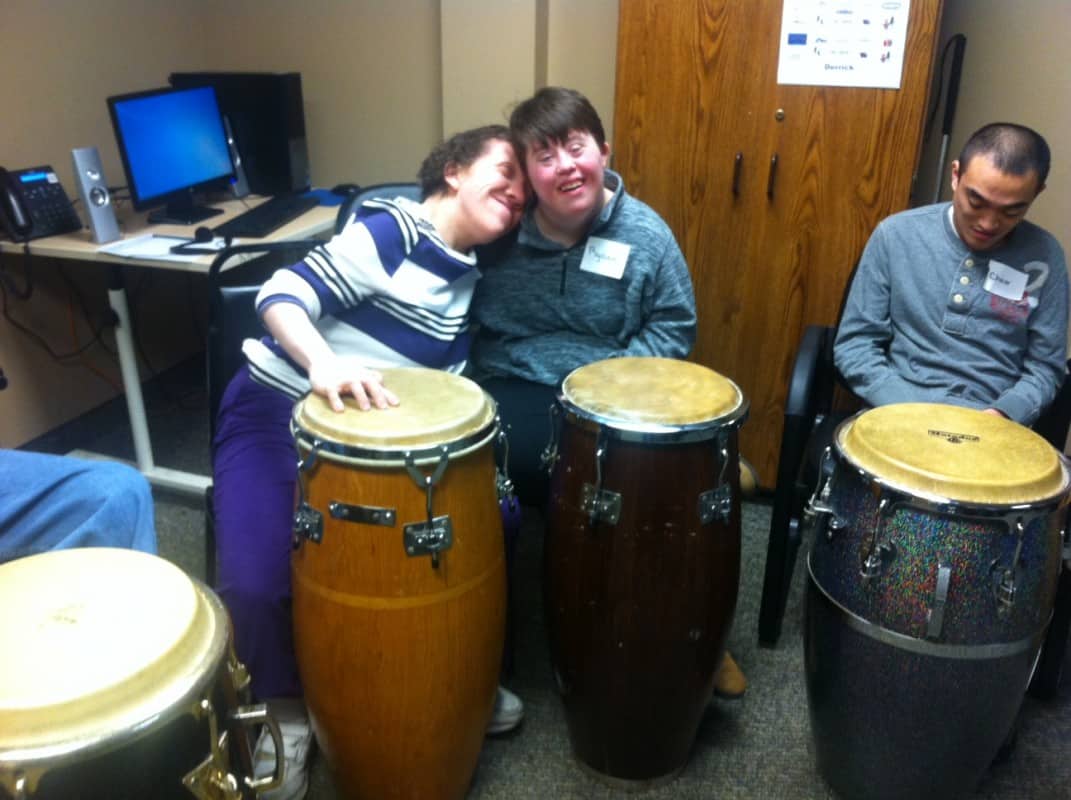
more...
NGC 613 is a barred spiral galaxy located some 67 million light years away in the southern constellation of Sculptor. It is a candidate outlying member of the Sculptor Group, a gravitationally-bound group of galaxies. This galaxy was discovered in 1798 by German-English astronomer William Herschel, then re-discovered and catalogued by Scottish astronomer James Dunlop. It was first photographed in 1912, which revealed the spiral form of the nebula. During the twentieth century, radio telescope observations showed that a linear feature in the nucleus was a relatively strong source of radio emission.
NGC 613 is inclined by an angle of 37° to the line of sight from the Earth along a position angle of 125°. The morphological classification of NGC 613 is SBbc(rs), indicating that it is a spiral galaxy with a bar across the nucleus (SB), a weak inner ring structure circling the bar (rs), and moderate to loosely wound spiral arms (bc). The bar is relatively broad but irregular in profile with a position angle that varies from 115–124° and dust lanes located along the leading edges. Star formation is occurring at the ends of the bar and extending along the well-defined spiral arms. The central bulge is readily apparent, with a radius of 14″.
The classification of the nucleus is of type HII, indicating a match to the spectrum of an H II region. Near the core, the stars have a velocity dispersion of 136 ± 20 km/s. The nucleus is a source of radio emission with the form of an inner ring with a radius of about 1,100 ly (350 pc) and a linear feature that is perhaps perpendicular to it. The latter consists of three discrete blobs spanning approximately 2,000 ly (600 pc).Observations suggest the presence of a supermassive black hole at the core with a mass in the range (1.9–9.6) × 107 times the mass of the Sun.
more...More Posts
- Oscar León
- Terry Garthwaite
- World Music Keturah
- Daily Roots Johnny Clarke
- Cosmos eMACS J1353.7+4329
- Arlo Guthrie
- Bela Fleck
- Lee Morgan
- Cootie Williams
- Major Holley
- Milt Buckner
- Blind Boy Fuller
- World Music Oghlan Bakhshi
- Daily Roots Capital Letters
- Cosmos Eta Carinae
- Mercedes Sosa
- Mitch Mitchell
- Frank Wright
- World Music Shono Alexander Arkhincheev
- Daily Roots Paketo Wilson
